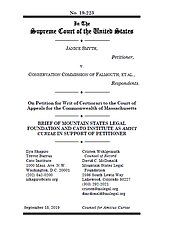The city of Falmouth had different ideas, however. Being a coastal community, the city passed the Falmouth Wetlands Protection Bylaw in 1998, creating various “no disturbance zones” around wetlands and coastal banks. In 2008, the city strengthened its bylaw and, as a result, the only developable part of Mrs. Smyth’s land is a 115 square foot section in the northwest corner. Mrs. Smyth applied for variances and even agreed to build a house half the size of the original plan, but the city wouldn’t budge. Her property that had been worth $700,000 was assessed at $60,000, a 91.5 percent reduction in value.
Mrs. Smyth sued, alleging that the denial of the permit was a regulatory taking under the Fifth Amendment. Regulatory takings are different from the simplest form of a taking—that is, when the government just takes physical possession private property. Regulatory takings, by contrast, occur when various regulatory actions strip substantial value from a piece of property. They’re a little harder to define, and it doesn’t help that the Supreme Court’s jurisprudence on regulatory takings is muddled.
Mrs. Smyth won at the trial court, but the Massachusetts appellate court overturned the verdict. According to the court, since Mrs. Smyth’s lot could possibly still be used “as a park or a playground” and because it may still be attractive to neighboring landowners to purchase as a “privacy” buffer, the property retained too much value to justify a takings claim.
The Massachusetts Supreme Judicial Court denied the appeal, so Mrs. Smyth has appealed to the Supreme Court. Cato has joined the Mountain States Legal Foundation in filing a brief supporting Mrs. Smyth’s petition. We argue that, rather than using the ad hoc balancing test of the Penn Central decision—a notoriously convoluted multi-part test—the Supreme Court should recognize that Mrs. Smyth incurred a “total taking” under the case of Lucas v. South Carolina Coastal Council.
The language in Lucas is clear: “When the owner of real property has been called upon to sacrifice all economically beneficial uses in the name of the common good, that is to leave his property economically idle, he has suffered a taking.” Mrs. Smyth’s property is the only remaining undeveloped lot in the residential neighborhood. She or her parents have been taxed for 40 years as if the lot was a prime residential property. When regulations have halted any development of a property, a categorical taking has occurred. No multi-part test is required. The Supreme Court should take the case to clarify that, if governments want to preserve environmental features, they shouldn’t be able to force all the costs on innocent property owners.

